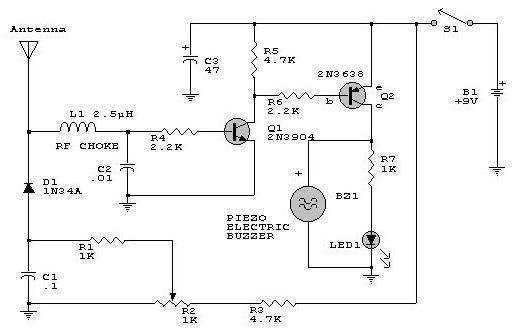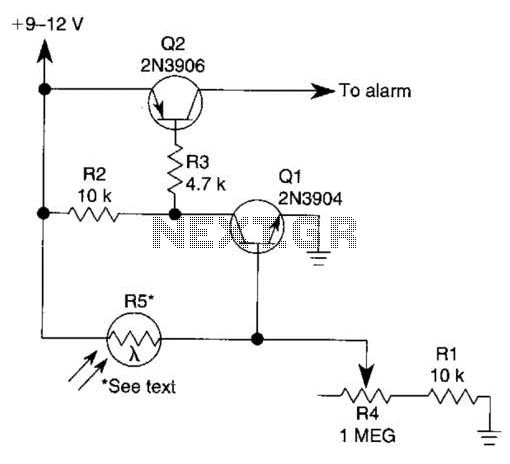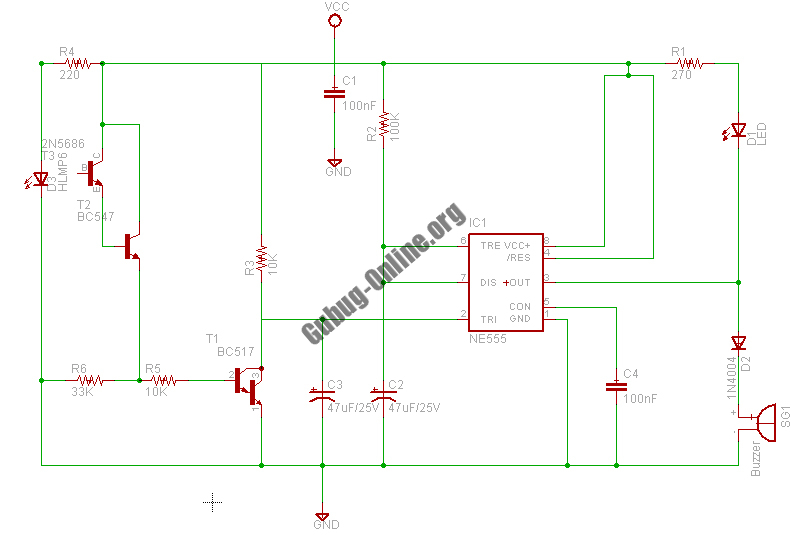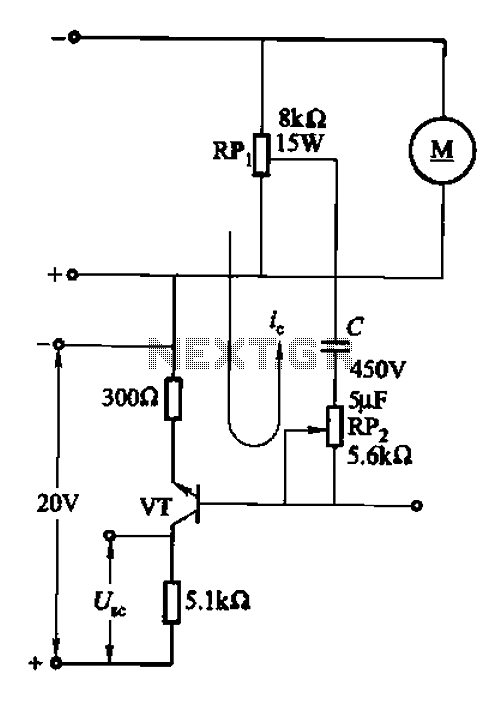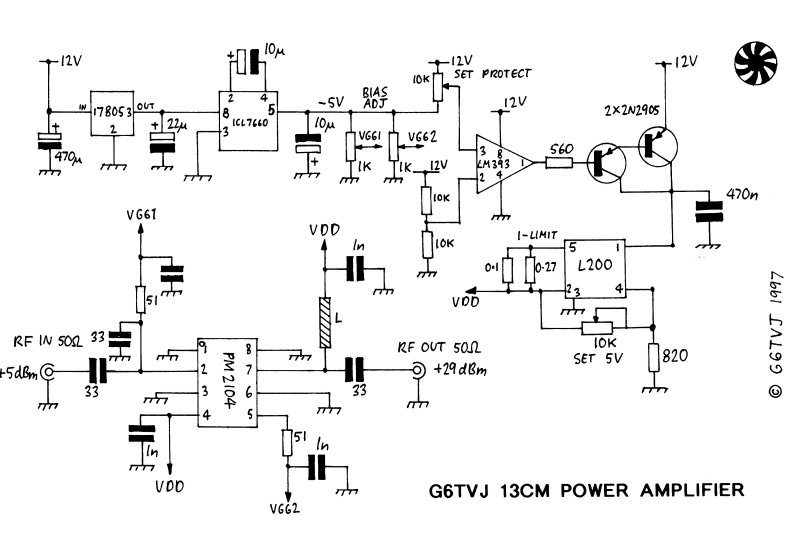
Broadband amplifier with bias compensation circuit diagram
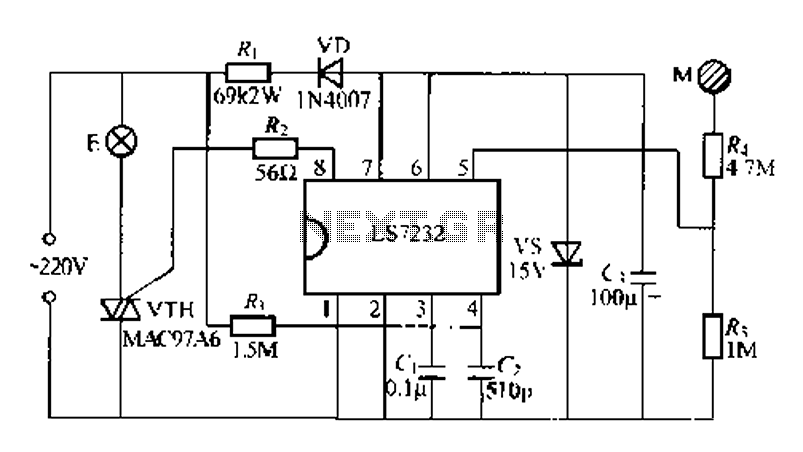
Figure (a) illustrates a general inverting amplifier circuit, which includes a 100k potentiometer as a feedback resistor connected in series between the input terminal and the inverting input to compensate for the DC bias current. The potentiometer (Rp) should be adjusted so that when the input voltage (Vi) is 0V, the output voltage (Vo) is also 0V. Indirect compensation is achieved through phase compensation capacitor C1 (90pF) and pin 5 connected to ground, along with filter capacitor C2, which is also 90pF. The circuit operates with voltage parameters of amplification (Av) at -10, a slew rate exceeding 70V/s, and a bandwidth greater than 400kHz. The gain-bandwidth product is approximately 30MHz. The circuit uses a 10-pin LH0003 circular metal package with an operating temperature range of 0 to 85 degrees Celsius and a storage temperature range of -65 to 150 degrees Celsius. The LH0003 chip can operate between -55 to 125 degrees Celsius, with the same storage temperature range. Figure (b) presents the pin configuration of the LH0003/LH0003C integrated chip.
The inverting amplifier circuit described is a fundamental building block in analog signal processing, functioning to invert and amplify input signals. The inclusion of the 100k potentiometer as a feedback resistor allows for fine-tuning of the circuit's gain, providing flexibility in applications requiring precise control over output levels. By setting the potentiometer to achieve a zero output voltage when the input is also zero, the circuit maintains stability and accuracy in signal processing.
The phase compensation capacitor (C1) plays a crucial role in stabilizing the amplifier by managing the phase shift introduced by the feedback network. This is particularly important in high-frequency applications where phase shifts can lead to instability and oscillation. The additional filter capacitor (C2) aids in reducing noise and improving the overall signal integrity.
With a voltage gain of -10, the circuit can effectively amplify signals while inverting their polarity. The specified slew rate of over 70V/s indicates the circuit's ability to respond rapidly to changes in input signals, making it suitable for dynamic signal applications. The bandwidth of over 400kHz ensures that the amplifier can process a wide range of frequencies, making it versatile for various electronic applications.
The gain-bandwidth product of approximately 30MHz suggests that as the gain increases, the bandwidth decreases, adhering to the principles of operational amplifier behavior. This characteristic is essential for designers to consider when selecting the amplifier for specific applications, ensuring that the desired gain does not compromise the frequency response.
The LH0003 integrated circuit is housed in a 10-pin circular metal package, which provides durability and thermal stability. The specified operating temperature ranges ensure reliable performance in diverse environmental conditions, making it suitable for industrial and commercial applications. The pin configuration detailed in Figure (b) facilitates easy integration into larger circuit designs, allowing engineers to leverage the capabilities of the LH0003/LH0003C in their electronic systems.Figure (a) shows the circuit with general inverting amplifier circuit differs only in that series with a 100k potentiometer feedback resistor between the input terminal and the inverting input, to compensate for the DC bias current. Adjust the potentiometer Rp, so when Vi 0V when, Vo 0. Indirect compensation pins for phase compensation capacitor C1 (90pF) 1 and 10, the pin 5 to ground filter capacitor C2 is also 90pF. The circuit shown in the voltage parameters of magnification: Av -10, its speed is greater than the voltage converter 70v/s, more than half-power bandwidth of up to 400kHz, the gain-bandwidth product of approximately 30MHz.
10-pin package LH0003 circular metal operating temperature is 0 ~ 85, storage temperature is -65 ~ 150. When LH0003 chip, the operating temperature of -55 ~ 125, storage temperature is -65 ~ 150. Figure (b) is LH0003/LH0003C integrated chip pin arrangement of FIG.
The inverting amplifier circuit described is a fundamental building block in analog signal processing, functioning to invert and amplify input signals. The inclusion of the 100k potentiometer as a feedback resistor allows for fine-tuning of the circuit's gain, providing flexibility in applications requiring precise control over output levels. By setting the potentiometer to achieve a zero output voltage when the input is also zero, the circuit maintains stability and accuracy in signal processing.
The phase compensation capacitor (C1) plays a crucial role in stabilizing the amplifier by managing the phase shift introduced by the feedback network. This is particularly important in high-frequency applications where phase shifts can lead to instability and oscillation. The additional filter capacitor (C2) aids in reducing noise and improving the overall signal integrity.
With a voltage gain of -10, the circuit can effectively amplify signals while inverting their polarity. The specified slew rate of over 70V/s indicates the circuit's ability to respond rapidly to changes in input signals, making it suitable for dynamic signal applications. The bandwidth of over 400kHz ensures that the amplifier can process a wide range of frequencies, making it versatile for various electronic applications.
The gain-bandwidth product of approximately 30MHz suggests that as the gain increases, the bandwidth decreases, adhering to the principles of operational amplifier behavior. This characteristic is essential for designers to consider when selecting the amplifier for specific applications, ensuring that the desired gain does not compromise the frequency response.
The LH0003 integrated circuit is housed in a 10-pin circular metal package, which provides durability and thermal stability. The specified operating temperature ranges ensure reliable performance in diverse environmental conditions, making it suitable for industrial and commercial applications. The pin configuration detailed in Figure (b) facilitates easy integration into larger circuit designs, allowing engineers to leverage the capabilities of the LH0003/LH0003C in their electronic systems.Figure (a) shows the circuit with general inverting amplifier circuit differs only in that series with a 100k potentiometer feedback resistor between the input terminal and the inverting input, to compensate for the DC bias current. Adjust the potentiometer Rp, so when Vi 0V when, Vo 0. Indirect compensation pins for phase compensation capacitor C1 (90pF) 1 and 10, the pin 5 to ground filter capacitor C2 is also 90pF. The circuit shown in the voltage parameters of magnification: Av -10, its speed is greater than the voltage converter 70v/s, more than half-power bandwidth of up to 400kHz, the gain-bandwidth product of approximately 30MHz.
10-pin package LH0003 circular metal operating temperature is 0 ~ 85, storage temperature is -65 ~ 150. When LH0003 chip, the operating temperature of -55 ~ 125, storage temperature is -65 ~ 150. Figure (b) is LH0003/LH0003C integrated chip pin arrangement of FIG.

